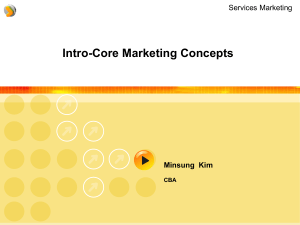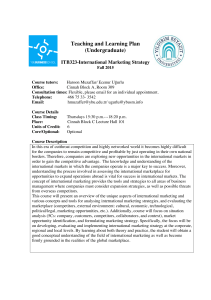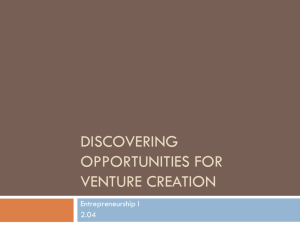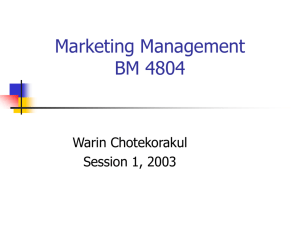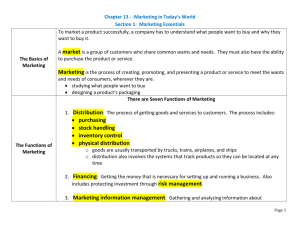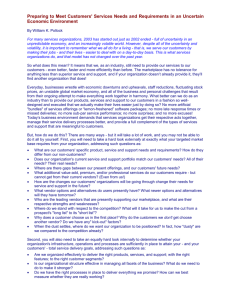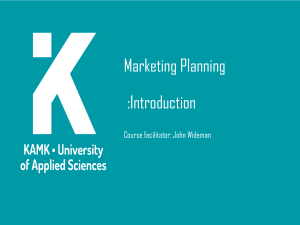Kotler_ch01
advertisement
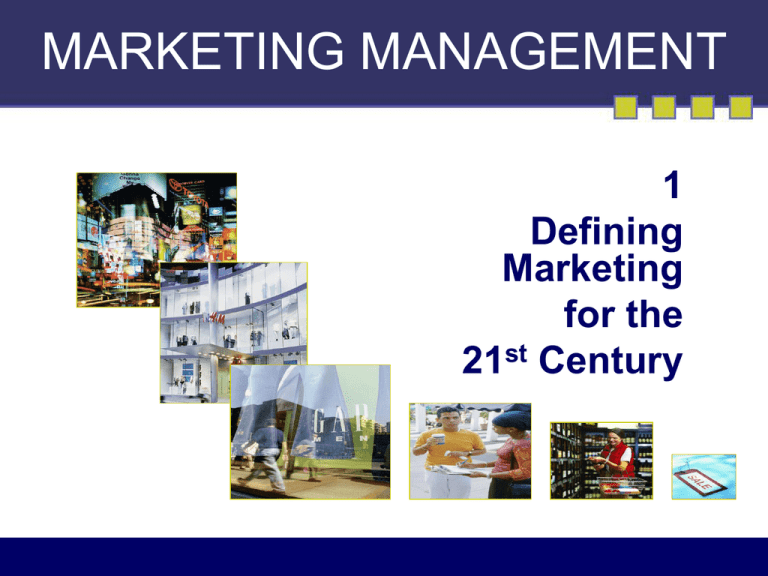
MARKETING MANAGEMENT 1 Defining Marketing for the 21st Century MARKETING MANAGEMENT In this chapter we will address the following questions: What is the new economy like? What are the tasks of marketing? What are the major concepts and tools of marketing? What orientations do companies exhibit in the marketplace? How are companies responding to the new challenges? Old Economy VS New Economy The old economy is based on the Industrial Revolution and on managing manufacturing industries WHILE … The new economy is based on the Digital Revolution and the management of information. The New Economy placed the following capabilities in the hands of consumer: Substantial increase in buying power Greater variety of available goods and services Great amount of information about practically anything Greater ease in interacting and placing and receiving orders An ability to compare notes on products and services AND placed the following capabilities in the hands of companies: Operate powerful new information and sales channels Collect richer information about markets, customers, prospects, and competitors Speed up internal communication among employees Have two-way communications with customers and prospects Send promotional tools easily and quickly Able to customize offerings Improve purchasing, recruiting, training and internal and external communication. Maintain cost saving while improving accuracy and service quality. Marketing and Exchange • What is marketing? The process of planning and executing the conception, pricing, promotion, and distribution of ideas, goods, and services to create exchanges that satisfy individual and organizational objectives 1-6 Selling is only the tip of the iceberg “There will always be need for some selling. But the aim of marketing is to make selling superfluous. The aim of marketing is to know and understand the customer so well that the product or service fits him and sells itself. Ideally, marketing should result in a customer who is ready to buy. All that should be needed is to make the product or service available.” Peter Drucker 1-7 What is Exchanged in Marketing? Goods Services Events & Experiences Persons Places & Properties Organizations Information Ideas 1-8 4 Types of Markets 1. 2. 3. 4. Consumer Market: (consumption) Business Markets: (saving/resell) Global Markets: (different offering mix) Nonprofit and Governmental Market: (bids) 1-9 Marketing Concepts and Tools Market: a collection of buyers and sellers Marketplace: a physical market (store) Marketspace: a digital market (Internet: e.g., www.secondlife.com) Metamarket: markets involving closelyrelated products and services (e.g., www.edmunds.com) Marketer and Prospect: A marketer is someone seeking a response from another party, called the prospect. 1-10 A Simple Marketing System 1-11 Structure of Flows in a Modern Exchange Economy 1-12 Marketing Concepts and Tools Needs: the basic human requirements Wants: specific objects that might satisfy the need Demand: wants for specific products backed by an ability to pay. Examples: An American needs food but wants a hamburger, French fries and soft drink. Many people want a Mercedes, only a few are able and willing to buy one. 1-13 Marketing Debate Does Marketers Create or Satisfy Needs? 1-14 Marketing Concepts and Tools Product: a value proposition Offering: intangible value proposition (a combination of products, services, information and experiences (Volvo) Brand: is an offering from a know source Examples: McDonald Lexus 1-15 Only the best is good enough for Lexus customers 1-16 Marketing Concepts and Tools Value is a ratio between what customer gets and what he gives Value = Benefits/Costs How to increase value? Raise benefits Reduce costs Raise benefits and reduce costs Raise benefits by more than the raise of costs Lower benefits by less than the reduction of costs 1-17 Marketing Concepts and Tools Exchange: a process of obtaining a product/service from someone by offering something For exchange to occur, there must be: • Two parties • Each with something of value to the other • Capable of communication and delivery • Free to accept/reject the offer • Agreement to terms Example: Caterpillar 1-18 Marketing Concepts and Tools Transaction: a trade of values between two or more parties. Does Transaction differs from Transfer 1-19 Marketing Concepts and Tools Relationship: building mutually satisfying long-term relations with key parties (customers, suppliers, distributor) in order to earn and retain their business. Network: building mutually profitable business relationships between the company and its supporting stakeholders. 1-20 Marketing Concepts and Tools Marketing channels: a way/mean to reach target market. Three kinds of marketing channels: Communication channels Distribution channels Service channels 1-21 Marketing Concepts and Tools Supply Chain: longer channel stretching from raw materials to components to final products that are carried to final buyers. Competition: all actual and potential rival offerings and substitutes that a buyer might consider. 1-22 Marketing Concepts and Tools Four (4) levels of competition: 1. 2. 3. 4. Brand competition: A company sees its competitors as other companies offering similar products and services to the same customers at similar prices. Industry competition: A company sees its competitors as all companies making the same product or class of products. Form competition: A company sees its competitors as all companies manufacturing products that supply the same services. Generic competition: A company sees its competitors as all companies that compete for the same consumer dollars. (Example: Volkswagen) 1-23 Marketing Concepts and Tools Marketing Environment: actors that impact the company’s offerings (task & broad environment). Marketing Program: a numerous decisions on the mix of marketing tools to use. Marketing Mix: a set of marketing tools the firm uses to pursue its marketing objectives in the target market. 1-24 The Four Ps 1-25 The Four Ps The Four Cs Marketing Mix Place Product Customer Solution Price ConvenPromotion ience Communication 1-26 Marketing-Mix Strategy 1-27 Marketing Management • Marketing Management (Kotler): is the analysis, planning, implementation, and control of marketing programs designed to create, build, and maintain mutually beneficial exchanges and relationships with target markets for the purpose of achieving organizational objectives. 1-28 Company Orientations to the Marketplace (Marketing Management Philosophies) 1. Production concept: assumes consumers favor those products that are widely available and affordable. (Focus: wide distribution; high volume). 2. Product concept: assumes consumers will favor those products that offer the most quality, performance, and features. (Focus: Superior product) 1-29 Company Orientations to the Marketplace, cont. 3. Selling concept: assumes that consumers will either buy or not enough of the organizations’ products unless the organization makes a substantial effort to stimulate the customer’s interest in the product. (Focus: needs of the seller) 1-30 The purpose of marketing is to sell more stuff to more people more often for more money in order to make more profit Coca-Cola’s former Vice president 1-31 Company Orientations to the Marketplace, cont. 4. Marketing concept: holds that the key to achieving organizational goals consists in determining the needs and wants of target markets and delivering the desired satisfactions more effectively and efficiently than competitors. (Focus: different needs of buyers) 1-32 Marketing and Selling Concepts Contrasted Starting Point Factory Focus Products Means Selling and Promoting Example Ends e.g., Profits through Volume (a) The Selling Concept Market Customer Needs Integrated Marketing e.g., Profits through Satisfaction (b) The Marketing Concept 1-33 Theodore Levitt’s “Marketing Myopia,” cont. –What is the difference between marketing and selling? –“The difference between marketing and selling is more than semantic. Selling focuses on the needs of the seller, marketing on the needs of the buyer. Selling is preoccupied with the seller’s need to convert the product into cash; marketing with the idea of satisfying the need of the customer ….” 1-34 Marketing Concept Four Pillar 1. Target Market: tailored marketing programs 2. Customer Needs: Giving customer what they need is not enough; companies must help customers learn what they want. Stated, Real, Unstated, Delight & Secret Needs. (Inexpensive car example) Responsive, Anticipated & Creative Marketer. Market-driving firm VS Market-driven firm. Make and sell VS Sense and respond Philosophy. Why it’s important to satisfy target customers? (Customer retention) 1-35 Marketing Concept Four Pillar 3. Integrated Marketing: all company’s departments work together to serve the customer’s interests. a. External marketing: directed at people outside the company. b. Internal marketing: the task of hiring, training, and motivating able employees who want to serve customers well. Which one is more important? 4. Profitability 1-36 Traditional Organization Chart Top Management Middle Management Front-line people Customers 1-37 Modern Customer-Oriented Organization Chart Customers Front-line people Middle management Top management 1-38 What makes companies adopt marketing concept? 1. 2. 3. 4. 5. Sales decline Slow growth Changing buying patterns Increasing competition Increasing marketing expenditures 1-39 Company Orientations to the Marketplace, cont. 5. The customer concept: • • Customer is the lifeblood of any company Customer is the King 1-40 The Customer Concept 1-41 Company Orientations to the Marketplace, cont. 6. The societal marketing concept: to determine the needs, wants, and interests of target markets and to deliver the desired satisfaction more effectively and efficiently than competitors in a way that preserves or enhances the consumer’s and the society’s well-being. 1-42 Societal Marketing Concept Marketing Managers Must Balance Profits Public Interest Promote sale of goods and services Long-term needs for a safe and healthy environment Dalrymple & Parsons/Marketing Management 7th edition: Chapter 1 16 1-43 How are companies responding to the new challenges? 1. 2. 3. 4. 5. 6. 7. 8. 9. Reengineering Outsourcing E-Commerce Benchmarking Alliances Partner-Suppliers Market-central Global and local Decentralization 1-44
